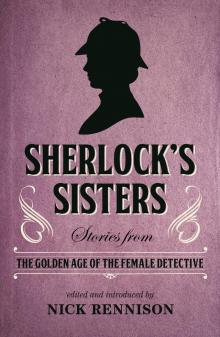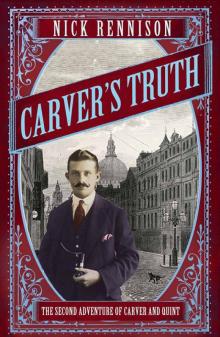- Home
- Nick Rennison
Sherlock's Sisters
Sherlock's Sisters Read online
CRITICAL ACCLAIM FOR NICK RENNISON
MORE RIVALS OF SHERLOCK HOLMES
‘This collection, like its predecessor Rivals of Sherlock Holmes, is a delight for fans of the history of crime writing and lovers of the short story mystery format. I can’t think of a more pleasant afternoon’s reading than this. Fun and informative’ – Paul Burke, NB Magazine
‘Writer, editor and Victorian specialist Nick Rennison does and has produced another fascinating anthology of stories from “the golden age of gaslight crime”’ – Mike Ripley, Shots Mag
‘Rennison set out to demonstrate the range and variety of late Victorian and Edwardian detective fiction... I’d say that he has succeeded in this aim’ – Martin Edwards, Do You Write Under Your Own Name
Supernatural Sherlocks
‘An unsettling and entertaining read!’ – Lizzie Hayes , Promoting Crime Blogspot
‘The Sherlock boom of the late 19th century also sparked a craze for stories of the supernatural and these are celebrated in Nick Rennison’s new anthology Supernatural Sherlocks’ – Mike Ripley, ShotsMag
THE RIVALS OF SHERLOCK HOLMES
‘An intriguing anthology’ – Mail on Sunday
‘A book which will delight fans of crime fiction’ – Verbal Magazine
‘It’s good to see that Mr Rennison has also selected some rarer pieces – and rarer detectives, such as November Joe, Sebastian Zambra, Cecil Thorold and Lois Cayley’ – Roger Johnson, The District Messenger (Newsletter of the Sherlock Holmes Society of London)
THE RIVALS OF DRACULA
‘These 15 sanguinary spine-tinglers… deliver delicious chills’ – Christopher Hirst, Independent
‘A gloriously Gothic collection of heroes fighting against maidens with bone-white skin, glittering eyes and blood-thirsty intentions’ – Lizzie Hayes, Promoting Crime Fiction
‘Nick Rennison’s The Rivals of Dracula shows that many Victorian and Edwardian novelists tried their hand at this staple of Gothic horror’ – Andrew Taylor, Spectator
‘The Rivals of Dracula is a fantastic collection of classic tales to chill the blood and tingle the spine. Grab a copy and curl up somewhere cosy for a night in’ – Citizen Homme Magazine
To Eve with love and thanks
INTRODUCTION
Female detectives make their first appearances surprisingly early in the history of crime fiction. The 1860s was not a decade in which women in real life had much scope to forge independent careers for themselves, particularly in the field of law enforcement, but, in the pages of novels and short stories, they were already busy solving crimes and bringing villains to justice. Andrew Forrester’s 1864 book The Female Detective (recently republished by the British Library) introduced readers to the mysterious ‘G’, a woman enquiry agent employed by the police who sometimes goes by the name of ‘Miss Gladden’. There had been women who turned detective in fiction before. Wilkie Collins’s short story entitled ‘The Diary of Anne Rodway’, for example, was published in 1856 in Dickens’s magazine Household Words, and has a heroine who investigates the suspicious circumstances of a friend’s death. However, Forrester’s character seems to have been the first professional female detective in British fiction. Like ‘Miss Gladden’, ‘Andrew Forrester’ was a pseudonym. The author’s real name was James Redding Ware (1832-1909), a novelist, dramatist and writer for hire in Victorian London who produced books on a wide variety of subjects from card games and English slang to dreams of famous people and the lives of centenarians. The Female Detective consists of a number of ‘G’’s cases, narrated by herself, in which she deploys her deductive and logical skills to reveal the truth.
The Female Detective, and other titles such as WS Hayward’s Revelations of a Lady Detective which appeared at about the same time, were published as ‘yellowbacks’. These were cheaply produced books, so called because of their covers which often had bright yellow borders. They were sold mostly at the bookstalls which had recently sprung up at railway stations across the country, and were intended as easy, disposable reads for train journeys.
For nearly twenty-five years, Miss Gladden and Mrs Paschal, the heroine of Hayward’s book, had no real successors in English fiction. The third woman detective did not put in an appearance until 1888 when Leonard Merrick (1864-1939) made Miriam Lea, a former governess turned private investigator, into the central character of his short novel Mr Bazalgette’s Agent. Employed by Mr Bazalgette’s detective agency, Miriam pursues an embezzler halfway across Europe in what is a charming, skilfully written narrative. Unfortunately her creator, Leonard Merrick, who was in his early twenties when he wrote Mr Bazalgette’s Agent, came to hate it. He went on to become a well-respected novelist whose admirers included HG Wells, JM Barrie and GK Chesterton. George Orwell enjoyed his novels and wrote a foreword to a new edition of one of them. In later life Merrick clearly saw his detective story as an embarrassment – ‘the worst thing I wrote’, he called it – and made every effort to cover up its existence. He took to buying up copies of the book and destroying them which explains why only a handful now remains in existence. Luckily, the British Library republished it in their ‘Crime Classics’ series in 2013 so readers today can see that Merrick was unjustly severe on his own work.
By 1890 there had only been a very small number of pioneering women detectives in crime fiction but that was about to change. Two phenomena dictated that change. One was the astonishing increase in the number of magazines and periodicals in the last decade of the nineteenth century. Between 1875 and 1903, that number nearly quadrupled from just short of 700 to more than 2,500. Not all of them, of course, carried crime stories but a significant proportion did. The market for all kinds of what would later be called ‘genre’ fiction, but especially crime stories, grew exponentially.
The other factor was the advent of Sherlock Holmes. The great detective’s debut in A Study in Scarlet, published in Beeton’s Christmas Annual for 1887, did not immediately start the Holmes craze. It was only when The Strand Magazine began to publish the short stories featuring Holmes and Dr Watson four years later that the public took the characters to its collective heart and worldwide fame beckoned. The success of the Holmes stories was so startling that soon every fiction magazine was looking to duplicate it and writers of all kinds were hoping to come up with a detective as appealing.
Between 1891 and the outbreak of the First World War, dozens and dozens of crime-fighting characters made their bow in the periodical press. Each writer strove to make his detective stand out from the crowd. Provide your creation with some kind of USP and you might, at least in your dreams, attain the kind of success Conan Doyle had done. So a blind detective (Ernest Bramah’s Max Carrados), a detective who was a Canadian woodsman (Hesketh Prichard’s November Joe), a Hindu from a remote Indian village (Headon Hill’s Kala Persad), and many more with a bewildering variety of talents, characteristics and geographical origins were sent out into the world to attract potential readers.
Among all the competing sleuths, a significant number were women. These female detectives were almost as diverse as their male counterparts. Some had special talents which helped them in their work. Richard Marsh’s Judith Lee, who appeared in a series of stories published in The Strand Magazine in 1911, was a lip-reader who was forever spotting crooks discussing their nefarious plans. Diana Marburg, the so-called ‘Oracle of Maddox Street’, who was created by the writing partnership of LT Meade and Robert Eustace, was a palm-reader, although she solved her cases more through the application of observation and common sense than through her skill at interpreting lines on the hand. Several of the women detectives, most notably George R Sims’s Dorcas Dene, had
been actresses and their stage experience came in handy when they were donning disguises to pursue villains.
Many of the female detectives from the late Victorian and Edwardian periods were women obliged, for a variety of reasons, to make their own way in the world without the support of husband or family. They were resourceful and swift to adapt themselves to new circumstances. Catherine Louisa Pirkis’s Loveday Brooke had been ‘thrown upon the world penniless and almost friendless’ by ‘a jerk of Fortune’s wheel’ but she becomes the leading light in Ebenezer Dyer’s detective agency. ‘She has so much common sense that it amounts to genius,’ her boss remarks. Mollie Delamere, the heroine of Beatrice Heron-Maxwell’s 1899 book, The Adventures of a Lady Pearl-Broker, is a young widow who has no assured income. ‘People seem to think it a disgrace that one’s husband should not leave one enough to live on,’ she wryly comments. She takes a job as an agent for pearl merchant Mr Leighton. This exposes her to many dangers and adventures, all of which she takes in her stride.
The 1890s and 1900s were an era in which feminism was on the rise. Educational opportunities were increasing. More and more women were demanding access to professions like medicine and journalism. They wanted to challenge men in what had previously been exclusively masculine domains. It is no surprise that the crime fiction of the time provided plenty of examples of what was called ‘The New Woman’ in action. Grant Allen’s Lois Cayley is a graduate of Girton College, Cambridge. In the course of her globe-trotting adventures, she wins a bicycle race, exposes the charlatanry of a quack doctor, rescues a kidnapped woman and kills a tiger. By doing so she amply proves herself to be a match in spirit and intelligence for any man. The eponymous protagonist of M McDonnell Bodkin’s Dora Myrl: The Lady Detective is a brilliant mathematician with a medical degree. Unable to get a practice, she has tried various jobs (including journalism) before she falls into detective work. There her gifts and personality finally come into their own. Bodkin was a prolific writer whose earlier creations had included a male detective named Paul Beck. In a later book, Beck and Dora work together and eventually marry.
Like Dora Myrl, many of the female detectives from the decades before the First World War were created by men. This was largely a simple reflection of the fact that the majority of the stories of all kinds in the periodical press were written by men. However, there were plenty of women writers publishing stories in magazines like The Strand, Pearson’s Magazine, The Idler and the dozens of competing titles which could be found in newsagents and on railway bookstalls. Possibly the best example of such a woman is LT Meade who, with her regular collaborator Robert Eustace, makes two appearances in this anthology. Miss Florence Cusack and Diana Marburg, the ‘Oracle of Maddox Street’, are among many series characters that the immensely productive Meade created, both with and without the assistance of other writers.
In America, women writers such as Anna Katharine Green produced early examples of detective fiction but women detectives were few and far between before 1900. Those that did appear were mostly published in so-called ‘dime novels’, the transatlantic equivalents of the ‘yellowbacks’ and cheap railway formats which, in Britain, had provided a home for Miss Gladden and Mrs Paschal. Characters such as the heroine of Madeline Payne, the Detective’s Daughter, published in 1884, Mignon Lawrence, a feisty New Yorker sent west in pursuit of a bad guy, and Caroline ‘Cad’ Metti, a beautiful Italian-American who took centre stage in several stories in the 1890s, were the chief protagonists of entertaining potboilers with little pretension to literary merit.
In the first two decades of the twentieth century the woman detective migrated from the pages of the dime novel to more respectable literature. Anna Katharine Green was the author of The Leavenworth Case, an 1878 novel which introduced the detective Ebenezer Gryce to American readers. Twenty years later, Green created Amelia Butterworth, a high-society spinster with a taste for poking her nose into other people’s misfortunes, who joined forces with Gryce to solve crimes in three novels, beginning with That Affair Next Door (1897). In 1915, nearly forty years after her first detective novel, Green published a series of short stories featuring Violet Strange, a young woman from a wealthy New York family who earns her pin money working for a detective agency. One of these is included in this anthology. Arthur B Reeve’s Constance Dunlap is another young woman who makes a living from fighting crime. Reeve is best known for creating the ‘scientific detective’ Craig Kennedy who appeared in dozens of short stories, more than twenty novels, several films and a 1950s TV series. He was a much less sophisticated writer than, say, Anna Katharine Green, and both his Craig Kennedy stories and his tales of Constance Dunlap reflect that, but they retain their charm and are full of fascinating period detail. ‘The Dope Fiends’, the story I have included in this anthology, reveals much, both consciously and unconsciously, about attitudes to drug-taking in the 1910s.
In the several anthologies I have compiled (The Rivals of Sherlock Holmes, More Rivals of Sherlock Holmes, The Rivals of Dracula, Supernatural Sherlocks), my aim has always been to demonstrate the sheer range of entertaining short fiction that was produced in the late Victorian and Edwardian eras. My purpose in putting together this volume is the same. From a palm-reading society lady (Diana Marburg) to the gypsy owner of a pawnshop (Hagar Stanley), from a Scotland Yard detective (Lady Molly) solving crimes years before women in real life were even allowed to join the police force to a nurse of genius (Hilda Wade) looking to revenge the death of her father, the female detectives of this golden age of genre fiction were a gloriously mixed bunch. I hope that readers enjoy their assorted adventures as much as I do.
DORA BELL
Created by Elizabeth Burgoyne Corbett (1846-1930)
A journalist who worked for the Newcastle Daily Chronicle, Elizabeth Burgoyne Corbett also wrote a number of interesting genre novels. New Amazonia: A Foretaste of the Future, first published in 1889, is a feminist utopia in which her heroine falls asleep in the late nineteenth century and awakes in the year 2472 to find a society in which women have control. Thanks to a technique known as ‘nerve-rejuvenation’, these ‘Amazonians’ live for hundreds of years in the prime of life and have created a fairer and less corrupt world. (Although, disconcertingly for a modern reader, they do practise a form of eugenics.) Corbett was not only a pioneer of women’s science fiction. She also published crime novels. In When the Sea Gives Up Its Dead, subtitled ‘A Thrilling Detective Story’, Annie Cory turns detective when her fiancé is falsely accused of stealing diamonds from the firm for which he works. Adopting a series of alternative identities and disguises (including cross-dressing as a man), Annie sets out to prove his innocence. The book was published in 1894. At about the same time, Corbett created another female detective in Dora Bell, an agent for the Bell & White Agency, who appeared in a series of stories published in provincial and colonial newspapers such as the Leeds Mercury and the Adelaide Observer. These do not seem to have been collected in book form although an earlier volume of stories by Corbett, Secrets of a Private Enquiry Office (1890), does include a character named Dora. The Dora Bell stories are short and uncomplicated, ideally suited to the newspaper readership at which they were aimed. They win no prizes for great originality but they remain entertaining and easy to read.
MADAME DUCHESNE’S GARDEN PARTY
‘It cost more than two hundred pounds, Miss Bell. But that is not the worst of the matter. My aunt stipulated that I should always wear it as a perpetual reminder of her past kindness and her future good intentions, and if she misses it I shall lose favour with her altogether. To lose Miss Mainwaring’s favour means to lose the splendid fortune which is hers to bequeath, so you see how very serious the matter is for me. It is, indeed, little short of life and death, for poverty would kill me now. For God’s sake do your best for me.’
‘But surely, if Miss Mainwaring knows that you could not possibly have foreseen your loss, she will not be unjust enough to disinherit you?�
�
‘Indeed she will. She believes me to be vacillating and unreliable, because I broke off an engagement with a rich man to whom I had but given a reluctant acceptance, and united myself to the man of my choice. My husband was poor, and therefore beyond the pale of forgiveness, and my own pardon is only based on the most unswerving obedience to all my aunt’s injunctions. The pendant came from India, and the stones in it are said to possess occult power – I wish they had the power to come back to their rightful owner.’
The speaker heaved a sigh of desperation as she spoke, and I glanced at her with considerable interest. She was tall, pale, dark-eyed, and handsome, but her appearance bore certain signs of that vacillation and carelessness of which her aunt accredited her with the possession.
The circumstances surrounding the loss of which she complained were peculiar. She had been spending the evening at the house of the German Ambassador, and returning home in Miss Mainwaring’s carriage, when she became aware of the fact that she had lost the jewelled pendant which her aunt had given her as a token of reconciliation when she returned to her after being suddenly widowed.
A frantic search of the carriage bore no results, and Mrs Bevan hastily told the coachman to return to the Embassy. But she prudently refrained from confiding the particulars of her loss to him, for she was not quite without hope that it might be remedied. Madame von Auerbach was, however, able to give her no comfort, for she had herself suffered in like manner with her guest.
She had lost a valuable diamond-studded watch, and when the most careful search failed to discover it, the conclusion arrived at was that some thief must have been present at the reception. It was an unpleasant conclusion to arrive at. But it was the only natural one. For the Ambassador’s wife had not left her guests, or gone beyond the reception rooms, from the time she entered them, wearing the watch to the moment when, the last visitors having just gone, she thought of looking at her watch, and found that it had disappeared.

 American Sherlocks
American Sherlocks More Rivals of Sherlock Holmes
More Rivals of Sherlock Holmes Sherlock's Sisters
Sherlock's Sisters Carver's Truth
Carver's Truth